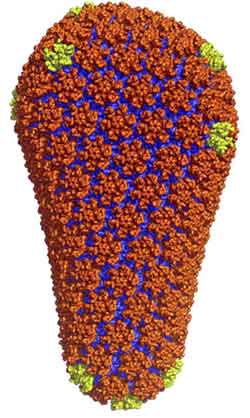How TRIM5 fights HIV

Structure of the shell<br>
Unlike people, certain monkey species, such as rhesus or night monkeys, are resistant to HIV thanks to TRIM5, a cellular protein: In the case of an HIV infection, the protein intercepts the virus as soon as it enters the cell and prevents it from multiplying. We have known about TRIM5 for over six years. However, the mechanism TRIM5 uses to prevent the HI virus from multiplying was still largely unknown.
The majority of the key aspects of TRIM5’s defense mechanism against HIV was discovered by the Swiss research teams of Prof. Jeremy Luban, University of Geneva, and Prof. Markus Grütter, University of Zurich, in collaboration with teams from the USA and France. They demonstrated that TRIM5 immediately triggers an immune response if infected with HIV. Consequently, TRIM5 is an HIV sensor in the innate immune system. Unlike the adaptive immune system, which only develops when confronted with a pathogen, the innate immune system is already able to eliminate pathogens as soon as it comes into contact with them.
The HI virus, which penetrates the cell during an infection, has a shell, the components of which are arranged in a lattice, similar to the pattern on a soccer ball. TRIM5 recognizes this lattice structure and specifically attaches itself to it. This stimulates the protein to produce signal molecules known as polyubiquitin chains in the cell. These chains immediately trigger an anti-viral reaction. The “alerted” cell can then start eliminating cells infected with HIV by releasing messenger substances (cytokines).
Humans also have a TRIM5 protein, but it is less effective in fending off HIV. However, the findings in resistant monkeys have opened up new possibilities and ways of fighting HIV in humans. 33 million people are currently infected with HIV worldwide; two million die of AIDS each year. And with 2.7 million people becoming infected every year, HIV remains a major problem.
References:
Pertel, T., Hausmann, S., Morger, D., Züger, S., Guerra, J., Lascano, J., Reinhard, C., Santoni, FA., Uchil, PD., Chatel, L., Bisiaux, A., Albert, ML., Strambio-de-Castillia, C., Mothes, W., Pizzato, M., Grütter, MG. & Luban, J. TRIM5 is an innate immune sensor for the retrovirus capsid lattice. Nature April 21, 2011.
Contact:
Prof. Markus Grütter
Department of Biochemistry
University of Zurich
Tel.: +41 44 635 55 80
Email: gruetter@bioc.uzh.ch
Media Contact
All latest news from the category: Life Sciences and Chemistry
Articles and reports from the Life Sciences and chemistry area deal with applied and basic research into modern biology, chemistry and human medicine.
Valuable information can be found on a range of life sciences fields including bacteriology, biochemistry, bionics, bioinformatics, biophysics, biotechnology, genetics, geobotany, human biology, marine biology, microbiology, molecular biology, cellular biology, zoology, bioinorganic chemistry, microchemistry and environmental chemistry.
Newest articles

Innovative 3D printed scaffolds offer new hope for bone healing
Researchers at the Institute for Bioengineering of Catalonia have developed novel 3D printed PLA-CaP scaffolds that promote blood vessel formation, ensuring better healing and regeneration of bone tissue. Bone is…

The surprising role of gut infection in Alzheimer’s disease
ASU- and Banner Alzheimer’s Institute-led study implicates link between a common virus and the disease, which travels from the gut to the brain and may be a target for antiviral…

Molecular gardening: New enzymes discovered for protein modification pruning
How deubiquitinases USP53 and USP54 cleave long polyubiquitin chains and how the former is linked to liver disease in children. Deubiquitinases (DUBs) are enzymes used by cells to trim protein…



